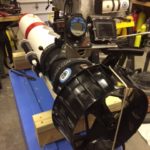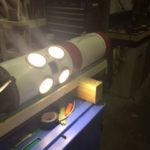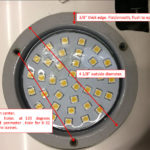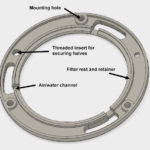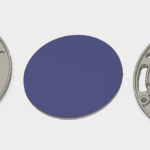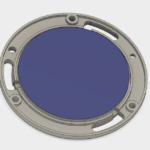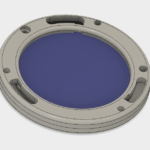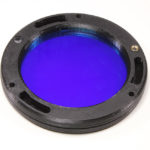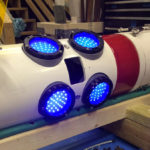Fluorescence Excitation Filters with Custom Holders for an Underwater Vehicle
I (NIGHTSEA founder Dr. Charles Mazel) was contacted by an old friend to provide fluorescence excitation filters for the LED lights on a new underwater exploration vehicle. Michael Lombardi is the creator of Oceans of Opportunity, of which Lombardi Undersea is a part. I got to know Mike during a large-scale research program on underwater optics being conducted at Lee Stocking Island, Bahamas, in the late ’90’s to early 2000’s, when he was supporting a colleague of mine. Mike then supported me on several additional diving projects. Since those early days Mike has firmly established himself as an underwater explorer, Dive Safety Officer, commercial diver, and more.
The new project is a custom diver propulsion vehicle for underwater scientific exploration vehicle intended for diverse extended range projects. It includes four high power LED light banks sealed in epoxy produced by Juice Robotics LLC, and Mike wanted to add the capability to use these to explore fluorescence.
(Click any image for larger view)
- Underwater vehicle (c) Michael Lombardi
- LED light banks on vehicle (c) Michael Lombardi
The idea of putting an excitation filter in front of a light is easy, but we had to make sure that no air would be trapped behind the filter. That could result in a pressure differential as the vehicle descended and the glass would break. There had to be provision for air and water to circulate through the filter holder to prevent any pressure buildup. Holes are easy, but we did not want any light to escape except the light that passed through the filter. I had addressed this question years before when I added excitation filters to high-powered lights on the Johnson Sea-Link manned submersibles for the first exploration for fluorescence at great depths (down to 1,000 meters). The lights were very different than the ones on Mike’s vehicle, but the idea is the same.
The solution was to create custom 3D-printed filter holders. The first figure below shows the dimensions that Mike sent me. The next figure shows the design for the custom filter holder.
- Dimensions of LED assembly
- Design for printed holder with channels
That second picture shows just one half of the holder. The filter rests on the lip, held in the center by the raised ridge. There are three cutouts in the perimeter that lead to the large holes. The second half of the holder is identical. When one is flipped over onto the other with the mounting holes lined up one set of the large holes will be facing inward to the vehicle and the other to the open water, but they will not be facing each other so there is no path for light to escape. The figures below show the assembly steps, the completed actual filter, and one mounted on the vehicle.
- Filter components (c) NIGHTSEA
- Excitation filter on holder half (c) NIGHTSEA
- Excitation filter assembled (c) NIGHTSEA
- Custom filter and holder (c) NIGHTSEA
- First completed assembly on vehicle for test (c) Michael Lombardi
- Completed assemblies on vehicle (c) Michael Lombardi
In the next to last photo you can also see a piece of yellow barrier filter material. This can be manually pivoted in front of the vehicle’s camera, or positioned to allow the diver to view fluorescence while under propulsion. As target fluorescent objects or biologics are viewed, they can be collected and stowed in a rosette of centrifuge tubes positioned within the nose of the vehicle. According to Mike, this vehicle addresses a number of challenges in carrying too much ‘stuff’ on deeper dives, which has limited efficiency and productivity on deep Mesophotic coral reef scientific dives in particular.
Now we just have to see what the system does in the field, and what new discoveries it will lead to!

